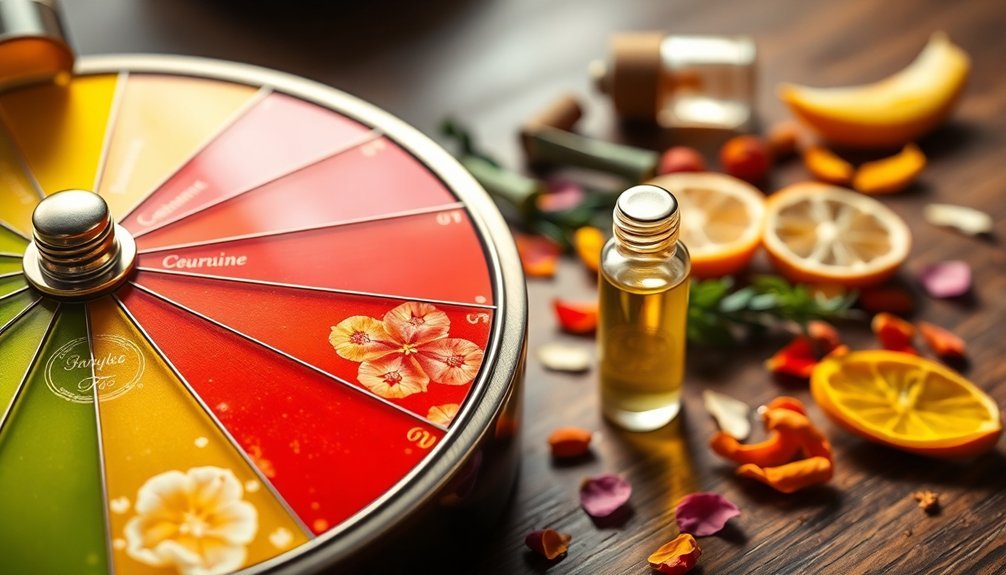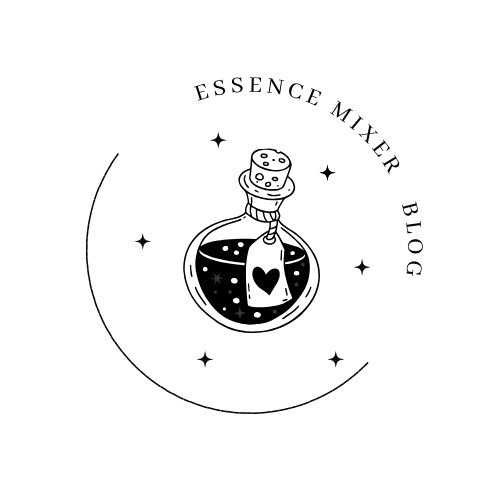The perfume wheel reveals five essential secrets to elevate your fragrance blending skills. You'll master complementary scent pairing by selecting opposite families, create harmony through adjacent note techniques, and build sophisticated layers across fragrance families. By understanding the interplay of top, heart, and base notes, you can craft unique signature blends that stand out. These expert techniques open up endless possibilities for your journey into professional-level scent creation.
Understanding Complementary Scent Pairing

When you're diving into the art of fragrance creation, understanding complementary scent pairing is essential.
You'll discover how selecting fragrances from opposite sides of the fragrance wheel creates enchanting contrasts that work together harmoniously. Take the combination of an Amber scent with a Fresh scent – the warm, rich notes perfectly balance the bright, clean characteristics.
You'll find that this technique adds complexity to your fragrance blend, opening up possibilities for unique fragrances that might surprise you.
Professional perfumers use this method to craft memorable scents that trigger diverse emotions and sensory responses. By mastering complementary pairs, you're able to create balanced compositions that appeal to a wider audience.
Think of it as creating a symphony where opposing elements enhance rather than compete with each other.
Mastering the Adjacent Note Technique
While complementary scents create striking contrasts, the Adjacent Note Technique offers a different approach to fragrance composition. By selecting scents from neighboring families on the fragrance wheel, you'll create harmonious blends that naturally enhance each other's characteristics.
The beauty of this technique lies in its intuitive nature. When you pair a floral scent with a fresh citrus scent, you're working with notes that share similar qualities while maintaining their distinct personalities.
The result is a balanced, sophisticated fragrance that's perfect for everyday wear. Before finalizing your blend, remember to test the combined scents on your skin, as the chemistry can affect the final outcome.
Don't be afraid of experimenting with different combinations – the Adjacent Note Technique provides endless possibilities for creating memorable olfactory experiences that feel natural and cohesive.
Strategic Layering With Fragrance Families

How can you elevate your signature scent? By mastering strategic layering with fragrance families, you'll reveal endless possibilities for creating unique aromatic notes that perfectly express your style.
Start by understanding the fragrance wheel's structure, which guides your scent blending journey. When layering fragrances, you can either pair kindred notes that sit next to each other, like florals with fruity scents, or explore complementary notes from opposite sides of the wheel, such as amber with marine notes.
Balance is key – combine lighter top notes with deeper base notes to achieve harmony. Don't hesitate to experiment with different subfamilies; try pairing a soft floral with woody oriental notes for unexpected depth.
The secret lies in understanding how these fragrance families interact, allowing you to craft sophisticated, personalized combinations.
Balancing Top, Heart, and Base Notes
Building on your layering expertise, mastering the balance between top, heart, and base notes reveals the full potential of your fragrance combinations. Understanding how these layers interact creates a cohesive fragrance that evolves beautifully throughout the day.
- Your top notes create the initial impression, lasting 15-30 minutes with light, volatile scents.
- Heart notes form your fragrance's core personality, featuring floral notes that bloom for several hours.
- Base notes anchor your scent with woody notes and rich ingredients that can last for days.
- Consider evaporation rates when blending to guarantee smooth shifts between layers.
- Aim for harmony between all three levels to achieve a balanced, sophisticated scent experience.
When you're fragrance blending, remember that each layer should complement the others, creating a seamless journey from the first spritz to the final lingering notes.
Creating Signature Blends Using Opposite Families

When you master the art of blending opposite fragrance families, you'll release endless possibilities for creating unique signature scents. The fragrance wheel serves as your guide, showing how floral and woody notes sit opposite each other, making them perfect complementary pairs. You'll discover that layering techniques, like applying floral top notes over woody bases, create depth and lasting power in your signature blends.
| Fragrance Family | Opposite Family | Blending Result |
|---|---|---|
| Floral | Woody | Balanced depth |
| Citrus | Amber | Fresh warmth |
| Oriental | Fresh | Rich lightness |
| Spicy | Aquatic | Exotic coolness |
| Sweet | Earthy | Grounded sweetness |
Experiment with these opposite families to craft your own distinctive aroma. Try pairing your favorite scent with its wheel opposite to create unexpected yet harmonious combinations that'll set your signature blend apart.
Frequently Asked Questions
What Is the 30 50 20 Rule for Perfume?
You'll want to blend your perfume using 30% top notes for first impressions, 50% middle notes for the main character, and 20% base notes for lasting power. This creates a balanced fragrance.
What Is the Fragrance Wheel Theory?
The fragrance wheel theory's a visual guide that'll help you understand how different scents relate to each other. You'll find four main families – Floral, Amber, Woody, and Fresh – with complementary and contrasting notes.
What Is the Ratio for Blending Perfume?
You'll want to follow the classic 30-50-20 perfume ratio: use 30% top notes for initial impact, 50% middle notes for the heart, and 20% base notes for longevity in your fragrance blend.
What Is the Perfume Trick?
You can create unique fragrances by pairing scents that are next to each other on the fragrance wheel. It's best to blend similar or complementary notes, focusing on the top, middle, and base layers.
In Summary
You've now mastered the essential techniques of the perfume wheel, from complementary pairings to strategic layering. Don't be afraid to experiment with your newfound knowledge – trust your nose and creative instincts. Whether you're blending adjacent notes or exploring opposite families, you'll create unique fragrances that express your personal style. Take these secrets and transform them into your own signature scents.





Leave a Reply